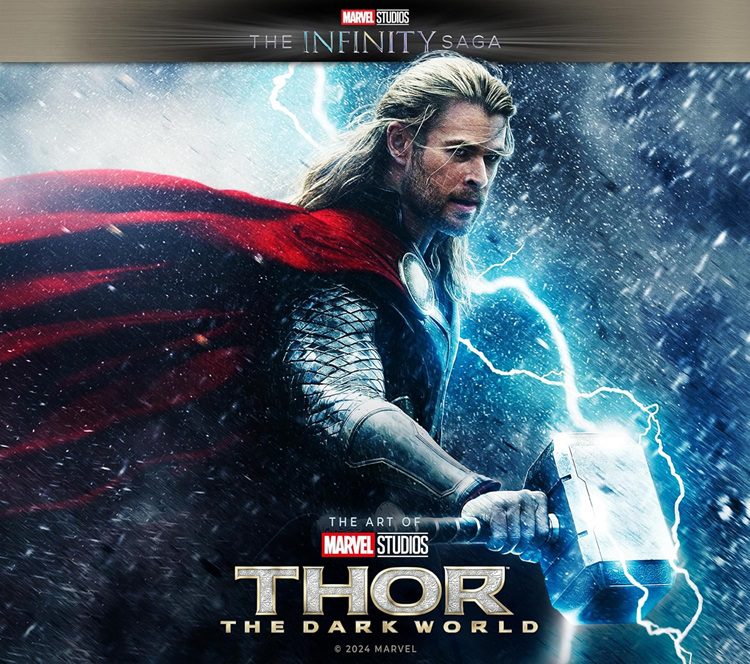
Marvel Studios: The Infinity Saga – The Art of Thor: The Dark World is the seventh release in the 24-book Marvel Studios: The Infinity Saga series, which is republishing previously released art books as a resized matching set. In his Foreward, Head of Visual Development at Marvel Studios Charlie Wen explains that “when we started development on Thor: The Dark World, [director] Alan Taylor came on the project with a distinct vision that I found equal parts challenging and compelling. He was adamant about finding ways to introduce practical elements as a way to ground these pre-existing characters and make them more tangible.”
Buy The Art of Thor: The Dark World bookThe book’s introduction presents the filmmakers talking about the movie with Marvel Studios President Kevin Feige stating, “Alan is bringing a grittier, more visceral, more textured patina to the designs of the worlds.” Writer/artist Walter Simonson, who is credited as a “strong influence” that “introduced both Malekith and the Dark Elves,” reveals the origin of the villain’s name. Concept artist Jackson Sze says they “wanted to give Asgard a more lived-in feel, with elements that are human-scale and filled with warmth.”
In Chapter One, “Return to the Gold Realm,” the artists’ exacting attention to detail is illustrated by things that didn’t get a lot of attention in the movie. A fold-out shows “the science behind the impending Convergence,” which appears like it was worked out on a chalkboard, and then a few pages are dedicated to the Book of Yggorasil. In regards to Thor’s new look, Wen says, “it is easy to identify how the leather and Norse-based knotting work together to create the functioning elements of a warrior, while still retaining elements of his regal heritage.” The new costume is a few images of concept art and a set photo. Thor’s hammer, Mjolnir, also received a redesign, as did the Warriors Three and Sif.
New creations to the Thor/MCU Universe include the Vanir people of Vanaheim, which “was shot traditionally in Bourne Wood in the Southeast of the United Kingdom, and the invading Marauders, whose aesthetic “was ‘kit-bash grungy space pirates,” according to Sze. One of them is a Kronan Stone-Man, the aliens Thor fought in Journey into Mystery #83, his Marvel Comics debut. Their storyboards for their battle are available on three pages.
Chapter Two, “Born of Eternal Night,” focuses on Malekith, Algrim/Kurse, and the Dark Elves. After a few pages dedicated to the creation of Malekith’s Ark, various looks created for Malekith are shown as well as character background, which was lacking in the movie, as stated in my review. Algrim and the Dark Elves get the same treatment. Prop Master Barry Gibbs explains the approach to their weapons and production designer Charles Wood does the same for the Harrow ship. Six pages of storyboards show the scene when Jane finds the Aether.
Chapter Three is “For Asgard,” which Feige says, “we wanted to see more of…than last time,” so in addition to revisiting locations (ex. Throne Room and Observatory) and characters (ex. Odin and Heimdall) and the approach for their redesigns, readers also learn about the new elements, such as the Training Grounds and the Dungeon, the latter of which housed Loki, who also was updated. The remainder of the chapter includes an animatic/previs of the Throne Room Crash and storyboards of the Death of [censored] to show how the sequences were initially planned out.
Chapter Four is more of the same as it predominantly features the animatics for the “Battle of Svartalfheim,” the movie’s climatic battle on the Dark Elves homeworld, in the middle of which occurs Jane’s “vision of universal cosmic destruction.” As with the other books in the series, the last chapter focuses on the movie’s marketing, which here is limited ton three posters.
Regardless of what one thought of the movie, The Art of Thor: The Dark World does a great job showcasing the wondrous art and the talented artists involved in the pre-production. Through the various drawings, the characters and locations jump off the pages, which present bold colors and rich blacks in various degrees.